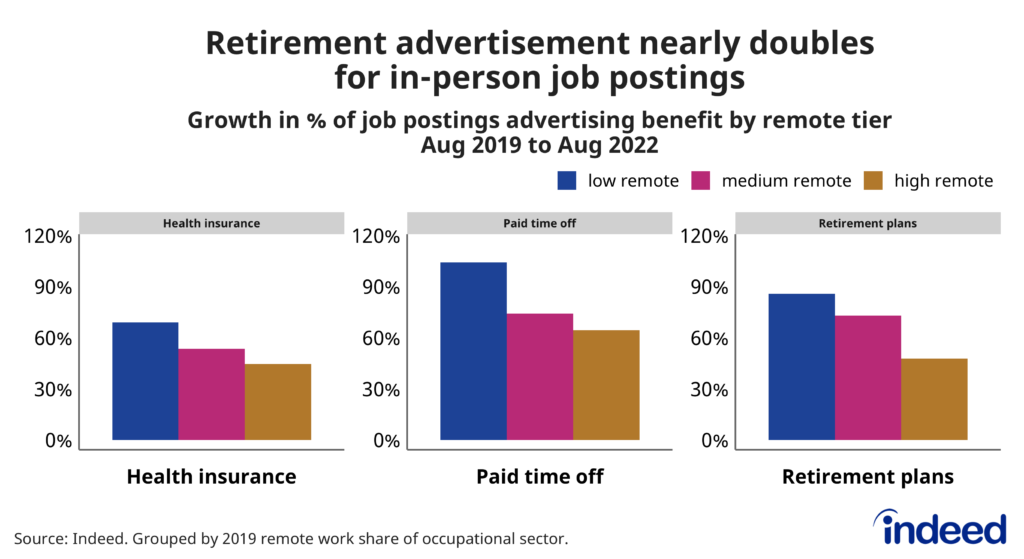Key Points:
- Indeed postings in low-wage sectors that are more likely to be in person have seen the fastest growth in advertisement of health insurance, paid time off, and retirement plans over the past three years.
- Job postings in in-person sectors nearly doubled advertisement of retirement plans from August 2019 to August 2022.
- Dental postings lead in advertisement of all three major benefits, with 62.4% of dental job ads in August 2022 highlighting paid time off.
- In 2021, relative job seeker interest skewed away from job postings sectors explicitly advertising health insurance, paid time off, or retirement plans to postings in sectors where such benefits are assumed.
When employers advertise a job, they choose what information to include. Job postings typically describe the work environment and compensation. Benefits too are often noted. In a tight labor market, it’s especially critical for employers to put their best foot forward. Showcasing benefits in job postings does just that, potentially enticing job seekers.
Hiring Lab’s first report on US benefits focuses on employer advertisement in Indeed job postings of three key nonwage forms of compensation — health insurance, paid time off, and retirement plans. Of course, the benefits employers advertise vary according to occupational sector. However, we found clear patterns apart from those sectors. The greatest increases in advertisement of health insurance, paid time off, and retirement plans have taken place in in-person, lower wage sectors, such as childcare and food service, rather than more-remote, higher wage areas of the economy. To be sure, advertisement of the three key benefit categories has climbed throughout the labor market. But the rise has been most substantial in sectors where employers have been scrambling for workers, and many of those jobs pay lower wages and require attendance at a worksite.
Job postings have gotten longer
Line graph titled “Advertising of benefits rising.” With a vertical axis ranging from 0% to 40%, Indeed tracked the percentage of job postings advertising benefits from January 2019 to May 2022, focusing on retirement plans, health insurance and paid time off as key benefits. Job postings have steadily increased their advertisement of these benefits during this time period.
Job postings on Indeed highlighting benefits have steadily increased. That may be one reason job descriptions have gotten wordier. From 2018 to 2021, the average character length of a job posting on Indeed jumped nearly 20%. But other factors are also at work. For example, many postings now include information related to the pandemic, such as remote work possibilities and vaccination requirements.
It’s important to understand that postings advertising benefits represent just a fraction of jobs that, in fact, provide those benefits. According to the Bureau of Labor Statistics 2022 benefits report, 70% of private industry workers had access to healthcare benefits in March 2022. But over the same period, only 43.4% of job postings on Indeed advertised health insurance. In other words, when job postings don’t advertise benefits, that doesn’t mean employers aren’t offering them.
Advertisement of benefits reflects a tight labor market
Across wage tiers, a substantial portion of job postings on Indeed advertise health insurance, paid time off, and retirement plans, and that share has increased steadily over the past three years. In August 2022, middle-wage job postings ($15- $20.38-an-hour) advertised these three benefits most. But benefit advertisement growth has been fastest in low-wage job postings (less than $15-an-hour).
The share of postings in low-wage sectors advertising health insurance increased 80% between August 2019 and August 2022. The growth in paid-time-off advertisement for this tier was even more impressive, up 103% over the same period. Growth in advertisement of retirement plans was close behind, up 96%. The shares of middle- and high-wage job postings advertising these benefits also grew, but not nearly as rapidly as in the low-wage tier.

Analyzing job postings by occupational sector sheds additional light on how a tight labor market influences employer choices about advertising benefits. Postings in sectors most likely to require in-person work experienced the fastest growth in advertisement of health insurance, paid time off, and retirement plans between August 2019 to August 2022. Interest in in-person work started to recover only this past spring and remote work remains popular. The obvious conclusion is employers in in-person sectors stepped up benefits advertisement to drum up interest in a tight labor market.
Dental job postings lead across all three major benefits
Across occupational sectors, job postings in dentistry, including dental assistant and hygienist, were most likely to highlight availability of the major benefits. The rise in advertising of retirement plans in this field has been particularly steep. In August 2019, 34.6% of dental job postings advertised paid time off. That rose nearly 28 percentage points to 62.4% by August 2022. Previous Hiring Lab research found 14.7% of dental job postings in July 2022 offered signing bonuses. Generous benefits and signing bonuses suggest dental employers are pulling out the stops to attract staff. This may reflect dentistry’s stiff licensing requirements, which leaves a smaller pool of qualified workers.
Installation & maintenance came in second in advertising health insurance and retirement plans. For paid time off, childcare was close behind dental, with 60.1% of job postings advertising it in August 2022.
Job seeker interest skews to sectors where key benefits are assumed
A tight labor market has prompted more employers to put their benefit packages on display. Yet job seekers have not shifted interest toward postings advertising benefits. Why? It’s probably because in many sectors job seekers generally take for granted benefits are available.
In postings in such higher-wage sectors as software development, banking & finance, and health insurance, paid time off, and retirement plans are advertised less than average. According to the Bureau of Labor Statistics, personal leave and vacation, health insurance, and retirement benefits are available more often in the financial services and information sectors than in lower-wage fields like leisure and hospitality and retail.
If it’s standard practice in an industry to offer certain benefits, there’s less need to showcase them in job postings. Job seekers in high-wage and high-remote occupations probably assume benefits like paid time off and retirement plans are provided.
In fact, job seeker interest skewed toward sectors where benefits have traditionally been offered. In 2021, workers shifted interest toward remote friendly and higher paying occupational sectors, precisely those where benefits are standard. Yet, those sectors are less likely to note paid time off, health coverage, and retirement plans in job postings, creating a false impression that job seekers are less interested in benefits. Put another way, job seekers were less interested in job postings that advertised key benefits to those assumed to offer them.
Conclusion
Health insurance, paid time off, and retirement plans are three benefits with wide appeal. Having health coverage, being able to take time off, and building a retirement nest egg are important to most, if not all, job seekers.
Postings on Indeed have broadly ramped up advertisement of these benefits, especially for lower-wage, in-person jobs. In some cases, the share of lower-wage, in-person job postings advertising key benefits more than doubled from August 2019 to August 2022. But highlighting these benefits doesn’t necessarily make job seekers bite, which may be because they have greater interest in jobs where such benefits are assumed.
Methodology
Job postings advertising health insurance are defined as those that include terms like “healthcare benefit,” “medical plan,” or “health coverage” in the job description. Job postings advertising paid time off are defined as those that include terms like “paid personal time,” “unlimited time off,” “paid holidays,” or “paid sick leave” in the job description. Job postings advertising retirement plans are defined as those that include terms like “401k,” “403b,” or “retirement plan” in the job description.



